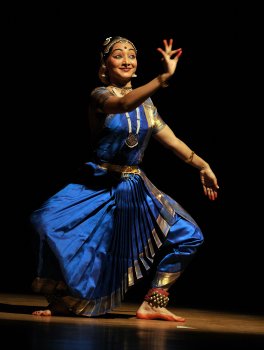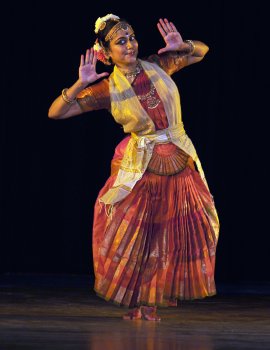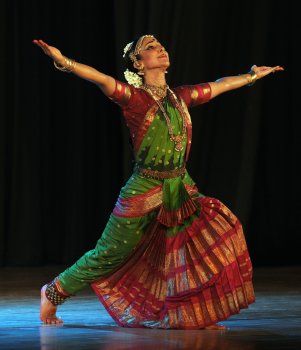
|   |

|   |
Madras Music Academy dance festival: Day 5 - Veejay Sai e-mail: vs.veejaysai@gmail.com Photos courtesy: Madras Music Academy January 23, 2013 Fresh and promising  The fifth day of the Academy’s dance festival opened on a cheerful note with Sandhya Easwar’s performance. Sandhya is a graduate of Kalakshetra with distinction and the winner of the Spirit of Youth Festival conducted by the Music Academy in 2012. Currently training under the watchful eyes of the Dhananjayans, Sandhya was a bundle of energy unfolding at her morning performance this season at the academy. The first thing that strikes you about her presence on stage is the effortless ease and sowkhyam she displays. She began her performance with an invocatory Pranavakaram set to ragam Arabhi, a composition of Oothukadu Venkata Kavi before she got onto the main piece of her dance, the Varnam. Her gurus, the Dhananjayans insist on renaming it as Nrithyopaharam. Opening with an elaborately rendered soulful aalapam on the violin by Easwar Ramakrishnan, Sandhya presented Sakhi inda velayil, a popular swarajathi by the Thanjavur Quartet set to ragam Ananda Bhairavi. While the sancharis on Lord Rajagopala got repetitive in the latter part, no one could doubt the clarity and precision in Sandhya’s lines. With Guru Shanta Dhananjayan wielding the nattuvangam and holding court, the shishya danced meticulously under her watchful eyes. Shanta is easily one of the finest and most efficient lady nattuvanars from the Kalakshetra baani. The next item Muruganin maru peyar azhagu, a composition penned by Guru Surajananda and set to tune in ragam Behag by TM Thyagarajan could have been vastly edited. Except for the heart-melting melody of JB Sruthi Sagar’s flute combined with Easwar’s violin, most of the composition was crammed with one too many stories on Lord Muruga being narrated endlessly. Does one need to tell all the tales from mythology when dealing with gods? Smart editing is yet a technique unknown to many in the dance world. The next composition, a javali by Ghanam Chinnayya, Sarigga Kongu in ragam Suruti is a timeless classic from the Kalakshetra repertoire. While Sandhya was once again pleasant in her demeanor, it would be good if she worked her way through her training in abhinaya. Radha Badri has a wonderful voice but her pronunciation of Telugu sahityam can be highly distracting. Sandhya concluded her performance with a Nrittangaharam composed by Dr. Mangalampalli Balamurali Krishna. If you wonder what that is, it is the nomenclature devised by her gurus for what is otherwise popular as a Thillana. Watching the display of Sandhya’s confidence in performing, one can’t help but recollect the wonderful archival footage of Leela Samson decades ago. Sandhya even carries off that kind of smile mingling with her side-glances, with panache. If she can be focused and work harder on her abhinaya, it won’t be too long before she evolves into a better dancer. Gift-wrapped nayika and Narasimha’s noodles  The morning continued into yet another performance of the Dhananjayan’s students. Firstly Shanta Dhananjayan must be congratulated for being a marathon nattuvanar, back to back, for two performances on the same morning. It was a great chance to see the guru’s untiring stamina for her art. Pavithra Srinivasan, currently pursuing her training under the Dhananjayans, began her recital with Siddhi Vinayakam set to ragam Mohana Kalyani, a composition of Harikesanallur Muthiah Bhagavatar as an invocation to Lord Ganesha. Continuing into the pada varnam Saami yenthani thelpudura, a composition of Subbarama Dikshitar in ragam Surutti, Pavithra got it announced that it was a ‘Nrithyopaharam’ and it was being reinterpreted to a different context. That it had gone above the mundane into the realm of spiritual and godhood and here the nayika was no longer pining for the king but god. As if this was not enough of unwanted distortion of the composition, as Pavithra turned around all one could see was a big flashy bow stuck to the back of her costume like a gift-wrapped nayika, now pining for the lord. The only consolation was Srikanth’s singing which was far better than what he normally does. While the nayika waited for the lord singing “Neerajakshi nikkamuga ninnukori unnadira,” her earring rattled on to the floor and with that kind of self-destruction even the lord didn’t turn up. Half-heartedly and totally distracted, Pavithra waded through the rest of the composition. In the final piece of her performance, Pavithra presented excerpts of Prahalada Charitam from the Bhagavata Puranam with music set to a ragamalika and talamalika composed by Guru VP Dhananjayan. Opening with an invocation to Lord Vishnu with “Sashanka chakram sakireeta kundalam,” the music meandered a bit into more popular compositions like ‘Bruhi mukundeti’. The whole composition got patchy with unnecessary elements of drama and Sanskrit dialogue with the pathra pravesh of demon Hiranyakashipu. While the ragas selected were absolutely beautiful, their application to some of the dramatic situations had a strong disconnect to the mood of the narrative and slowed down the performance to a large extent. What could have otherwise been a brilliant act, ideally more suitable for a male dancer, with the juxtaposition of the various rasas, ended up being lackadaisical. However the ending seemed to be the most unexpected one. One would have never expected Lord Narasimha to give such a peaceful death to the demon. He casually cajoled the demon to lie down on his lap and tickled him to death. Pavithra’s dance was totally bereft of any of the roudra rasa that was required for the characterization. Like a chef gently stirring a wok of noodles to assess how well they were cooked, Pavithra delicately twisted her fingers to open the stomach over what was supposed to be the dying demon king. One couldn’t deny the comic veracity of the presentation. According to the information provided, Pavithra Srinivasan trained in the Vazhuvoor style from Guru Rhadha, Kalanidhi Narayanan, Bhagavatulu Seetharama Sarma and currently the Dhananjayans. With all erudite gurus and so many years of training to flaunt, Pavithra could have put up a better performance. Of graceful movements and smiling faces  To say it all in one line: she came, she danced, she awed and she rocked! Mythili Prakash probably put up the best show at this year’s Academy festival. She not only exceeded everyone’s expectations but out-did her own potential at her presentation, raising standards a few notches higher. With Pongal festival around the corner, it was only apt that Mythili opened her performance with an ode to the sun god. A composition of one of the finest singers on the dance circuit, Debur Srivatsa from Bengaluru, this composition had excerpts from the Aditya Hridayam. Waving her hands like a garland to show the aura of flames around the sun god, Mythili blazed on stage under the wonderful lighting done by Venkatesh Krishnan. From there to the undeniable flavor of the Margazhi season: Andal! Dressed suitably in joyful green she continued into the next piece Aatkollavendum Aiyane written by G Vijayaraghavan with music set in a ragamalika by K Hariprasad. The nayika as Andal pleads with Lord Krishna to keep her close to him in his divine embrace. Noteworthy in this was Aditya Prakash’s singing. Aditya has certainly matured as one of the finest singers for dance over time. The brother-sister singer-dancer chemistry worked its magic like never before. While the ecstasy on Andal’s face was pleasing, the long jathis marred the flow of the composition. The finale had Mythili exhibit fine movements in the complicated wordy composition in Reetigowla. Mythili has certainly matured into more finesse from where she was. In one sequence where she was depicting a flowing river, Mythili’s hands and fingers stirred with polished effort. Her current training under Guru Malavika Sarukkai seemed to diligently reflect in her dance. JB Sruti Sagar’s flute, Eswar Ramakrishnan’s violin and Rajna Swaminathan’s mridangam accompaniment shone forth. Rajna’s soft and sensitive fingering technique on the mridangam was an attraction which no one could deny. Training under the legendary Umayalpuram Sivaraman, Rajna is one of the most promising female mridangam artistes we have on the music and dance scene. Showing the emotions of a betrayed nayika who was deceived by her friend, Mythili danced to Unnai Thoodhanupinen, a padam by Ghanam Krishnayyar in ragam Saveri. This oft-done composition is the tale of the nayika who sends her friend as a messenger to her lover, only to find her returning with tell-tale signs of an amorous encounter with him. Mythili established the characters with effortlessness and élan. Announcing her next piece as a tribute to the late sitar maestro Pandit Ravi Shankar, Mythili danced to a Tarana in ragam Nata Bhairavi. Once again Aditya’s vocal support while singing Hey nath, ham par kripa keejiye was remarkable in bringing out the mood of the composition. Ending her performance on that emotional note, Mythili got a standing ovation from the packed hall for her performance. This was easily one of the finest shows this season at the Music Academy. The trauma of being Draupadi  After the first performance for the evening, those who stayed back highly energized for the finale show for the evening were in for a disappointment with Panchali Sapatham, a group choreographic work by Urmila Sathyanarayanan. When one takes stories for adapting them to dance choreographies from epics, one needs to do thorough research on all aspects. The current work lacked even in the most basic of production qualities almost resembling a badly shaped high school show featuring a large chorus of unsynchronized girls, white-washed by their costume. Added to this was support that the orchestra was too tired to provide. Swamimalai Suresh who is otherwise good at his work also exhibited fatigue in his voice. Urmila, herself playing the role of Panchali wore something straight out of a nightmarish tele-serial. From faulty casting of characters to over-doing and stretching a scene for too long, the entire production lacked half the zest with which the smoke machines took off on the stage. By the second scene, the hall was fumigated enough and in that darkness many a rasika fled. Being a good Bharatanatyam soloist she could stick to the idiom that she is better at. In all this it was the rasikas’ and the festival’s loss. Wasn’t there some kind of screening process? Faulty programming could affect the prestige of the Academy’s festival. Veejay Sai is a writer, editor and a culture critic. |